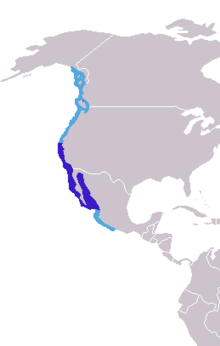California sea lion
| California sea lion | ||||||||||||
|---|---|---|---|---|---|---|---|---|---|---|---|---|

California sea lions |
||||||||||||
| Systematics | ||||||||||||
|
||||||||||||
| Scientific name | ||||||||||||
| Zalophus californianus | ||||||||||||
| ( Lesson , 1828) |
The California sea lion ( Zalophus californianus ) is an eared seal that is common along the North American coasts of the Pacific.
The California sea lion is recognized as a distinct species. It used to be listed as a subspecies of a common species alongside the Galápagos sea lions ( Zalophus wollebaeki ) and the extinct Japanese sea lions ( Zalophus japonicus ).
features
Although it is related to other sea lions ( Steller sea lion , New Zealand sea lion ), the California sea lion differs from them in shape. He is slimmer, his head is pointed and the bull's mane typical of other sea lions is missing. Males are up to 220 centimeters long and 400 kilograms in weight, females come to 180 centimeters and 90 kilograms. Bulls are dark brown in color, cows are significantly lighter.
distribution
The (actual) California sea lion has its colonies on the coasts of California and northern Mexico ; it is particularly prominent on islands, for example on the Channel Islands . Outside of the breeding season, the animals wander far and wide and reach Canadian coasts.
Way of life
California sea lions prefer sandy beaches and rarely stray far from the coast. When catching prey, they dive about 40 m deep and look for fish and octopus. The sea lions often dive in groups and circle schools of fish together. California sea lions are considered to be the most elegant and fastest of the seals. One example has already measured 40 km / h.
The reproductive behavior is similar to that of the other ear seals: the males arrive on the coast a few days before the females. As soon as the females arrive, the males begin to fight for their territories. In the course of these fights, younger and weaker males are pushed to inconvenient places on the edge of the colony. The females who are in the vicinity of the victorious bull form his harem.
In the colonies the sea lions live tightly packed; an individual rarely has more than 1 m² available. On average, a harem comprises 16 females; Depending on the location of the territory, it can be considerably more or a lot less. The previous battles ensure that the strongest males maintain the largest harems.
The females give birth to their young shortly after going ashore (as with all seals, only one cub per female), care for the offspring intensively for an estimated seven days and then mate with the bull. After two weeks the boys are very independent and form small associations in which they run around and play together.
Systematics
Traditionally, the California sea lion, the Galápagos sea lion ( Zalophus wollebaeki ) and the extinct Japanese sea lion ( Zalophus japonicus ) were listed as subspecies of a common species, but this was controversial. Wilson & Reeder already classified the three populations as separate species in 2005, following the view of DW Rice.
A molecular genetic study came to the conclusion that the SNPs of the mitochondria and cell nuclei justify a separation into several types. According to the molecular clock , the Californian and Galápagos sea lions separated around 2.3 (± 0.5) million years ago.
Humans and sea lions
When sea lions are shown in a zoo or circus , they are almost always this species because they are less aggressive and easier to tame than other sea lions.
The California sea lion has long been hunted for its skin and trans . The seal hunters nearly brought about the extinction of the species during the 19th century. The California population was extremely rare in the wild in the early 20th century. In 1908 there was only one sea lion left on the Channel Islands. There are now 75,000 sea lions on US coasts (including around 70,000 on the Channel Islands) and 85,000 on Mexican coasts.
literature
- Ronald M. Nowak: Walker's Mammals of the World . Johns Hopkins University Press, Baltimore / Maryland 1999, ISBN 0-8018-5789-9 .
- Don E. Wilson and DeeAnn M. Reeder: Mammal Species of the World, a Taxonomic & Geographic Reference. Johns Hopkins Univ. Press, 3rd ed., Baltimore 2005 ISBN 0-8018-8221-4 .
Web links
- Zalophus californianus in the endangered Red List species the IUCN 2006. Posted by: Seal Specialist Group, 1996. Retrieved on 12 May, 2006.
Individual evidence
- ^ DW Rice: Marine mammals of the world - Systematics and distribution. Society of Marine Mammalogy Special Publication Number 4, 1998
- ↑ JBW Wolf, Diethard Tautz and Fritz Trillmich: Galapagos and Californian sea lions are separate species: Genetic analysis of the genus Zalophus and its implications for conservation management. In: Frontiers in Zoology, 4:20, 2007.

